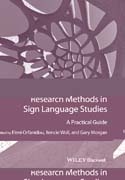
Research Methods in Sign Language Studies: A Practical Guide
Orfanidou, Eleni
Woll, Bencie
Morgan, Gary
Research Methods in Sign Language Studies is a landmark work on sign language research, which spans the fields of linguistics, experimental and developmental psychology, brain research, and language assessment.Examines a broad range of topics, including ethical and political issues, key methodologies, and the collection of linguistic, cognitive, neuroscientific, and neuropsychological dataProvides tips and recommendations to improve research quality at all levels and encourages readers to approach the field from the perspective of diversity rather than disabilityIncorporates research on sign languages from Europe, Asia, North and South America, and AfricaBrings together top researchers on the subject from around the world, including many who are themselves deaf INDICE: Notes on Contributors vii.Introduction 1.Eleni Orfanidou, Bencie Woll, and Gary Morgan.Part I Collecting Data WITH the Deaf Community 5.1 Ethics, Deaf–Friendly Research, and Good Practice When Studying Sign Languages 7.Jenny Singleton, Amber Martin, and Gary Morgan.2 The Deaf Community as a Special Linguistic Demographic : Diversity Rather Than Disability as a Framework for Conducting Research with Individuals Who Are Deaf 21.Thomas E. Allen.3 Dissemination and Transfer of Knowledge to the Deaf Community 41.Robert Adam.Part II Different Ways of Collecting Sign Language Data 53.4 Collecting and Analyzing Sign Language Data:.Video Requirements and Use of Annotation Software 55.Pamela Perniss.5 Transcription and Notation Methods 74.Onno A. Crasborn.6 Instrumented Measures of Sign Production and Perception:.Motion Capture, Movement Analysis, Eye–Tracking, and Reaction Times 89.Martha E. Tyrone.Part III Collecting Linguistic Data on Sign Languages 105.7 Sign Language Fieldwork 107.Victoria Nyst.8 Research Methods for Studying the Form of Signs 123.Rachel Channon.9 Methods of Research on Sign Language Grammars 141.Carol A. Padden.10 Documentary and Corpus Approaches to Sign Language Research 156.Jordan Fenlon, Adam Schembri, Trevor Johnston, and Kearsy Cormier.11 Methods in Carrying out Language Typological Research 173.Nick Palfreyman, Keiko Sagara, and Ulrike Zeshan.12 Data Collection in Sociolinguistics 193.Joseph C. Hill.Part IV Collecting Cognitive Data on Sign Languages 207.13 Research Methods in Psycholinguistic Investigations of Sign Language Processing 209.Jill P. Morford, Brenda Nicodemus, and Erin Wilkinson.14 Methods in Bimodal Bilingualism Research: Experimental Studies 250.Ronice Müller de Quadros, Deborah Chen Pichler,.Diane Lillo–Martin, Carina Rebello Cruz, L. Viola Kozak,.Jeffrey Levi Palmer, Aline Lemos Pizzio, and Wanette Reynolds.15 Studying Sign Language Acquisition 281.Amy M. Lieberman and Rachel I. Mayberry.16 Research Methods in Studying Reading and Literacy Development in Deaf Children Who Sign 300.Fiona E. Kyle .Part V Collecting Brain Data on Sign Languages 319.17 Studying Sign Language Processing Using Functional Neuroimaging Techniques: FMRI, ERP, MEG and TMS 321.Cheryl M. Capek and Helen J. Neville.18 Studying Sign Language Disorders: Considering Neuropsychological Data 336.Peter C. Hauser, David Quinto–Pozos, and Jenny L. Singleton.19 Using and Developing Language and Cognitive Assessments with Deaf Signers 352.Tanya Denmark and Joanna Atkinson.Index 000
- ISBN: 978-1-118-27142-1
- Editorial: John Wiley & Sons
- Encuadernacion: Rústica
- Páginas: 384
- Fecha Publicación: 24/02/2015
- Nº Volúmenes: 1
- Idioma: Inglés
